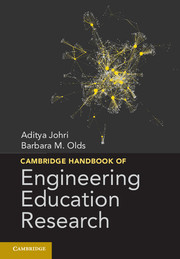Book contents
- Frontmatter
- Dedication
- Contents
- Editors
- Contributors
- Foreword
- Acknowledgments
- Introduction
- Chapter 1 Chronological and Ontological Development of Engineering Education as a Field of Scientific Inquiry
- Part 1 Engineering Thinking and Knowing
- Part 2 Engineering Learning Mechanisms and Approaches
- Chapter 8 Problem-Based and Project-Based Learning in Engineering Education
- Chapter 9 Case Studies in Engineering
- Chapter 10 Curriculum Design in the Middle Years
- Chapter 11 Engineering Design Education
- Chapter 12 Adaptive Expertise and Knowledge Fluency in Design and Innovation
- Chapter 13 Learning Disciplinary Ideas and Practices Through Engineering Design
- Part 3 Pathways into Diversity and Inclusiveness
- Part 4 Engineering Education and Institutional Practices
- Part 5 Research Methods and Assessment
- Part 6 Cross-Cutting Issues and Perspectives
- Index
- References
Chapter 11 - Engineering Design Education
Research, Practice, and Examples that Link the Two
Published online by Cambridge University Press: 05 February 2015
- Frontmatter
- Dedication
- Contents
- Editors
- Contributors
- Foreword
- Acknowledgments
- Introduction
- Chapter 1 Chronological and Ontological Development of Engineering Education as a Field of Scientific Inquiry
- Part 1 Engineering Thinking and Knowing
- Part 2 Engineering Learning Mechanisms and Approaches
- Chapter 8 Problem-Based and Project-Based Learning in Engineering Education
- Chapter 9 Case Studies in Engineering
- Chapter 10 Curriculum Design in the Middle Years
- Chapter 11 Engineering Design Education
- Chapter 12 Adaptive Expertise and Knowledge Fluency in Design and Innovation
- Chapter 13 Learning Disciplinary Ideas and Practices Through Engineering Design
- Part 3 Pathways into Diversity and Inclusiveness
- Part 4 Engineering Education and Institutional Practices
- Part 5 Research Methods and Assessment
- Part 6 Cross-Cutting Issues and Perspectives
- Index
- References
Summary
Introduction
Designing is a key component of professional practice in many fields of human endeavor (e.g., architecture, engineering, industrial design, art, and literature). For engineers, designing integrates engineering knowledge, skill, and vision in the pursuit of innovations to solve problems and enable modern life.
With this understanding, engineering educators have, for several decades, been infusing their programs with design curricula and pedagogical experiences in order to enhance the design competencies of engineering graduates. Paralleling the development of these curricula and experiences, a growing body of research has been providing a scholarly basis for engineering design education.
The goal of this chapter is to acquaint readers with engineering design education research and practice. To situate engineering design education in the larger context, we first present a brief history of research on design processes across several fields and then move to a more specific description of research on engineering design processes. We then focus on research that investigates effective ways to teach and assess the design process and review curricular structures and pedagogies that are commonly used in undergraduate engineering programs.
- Type
- Chapter
- Information
- Cambridge Handbook of Engineering Education Research , pp. 201 - 226Publisher: Cambridge University PressPrint publication year: 2014
References
- 49
- Cited by

